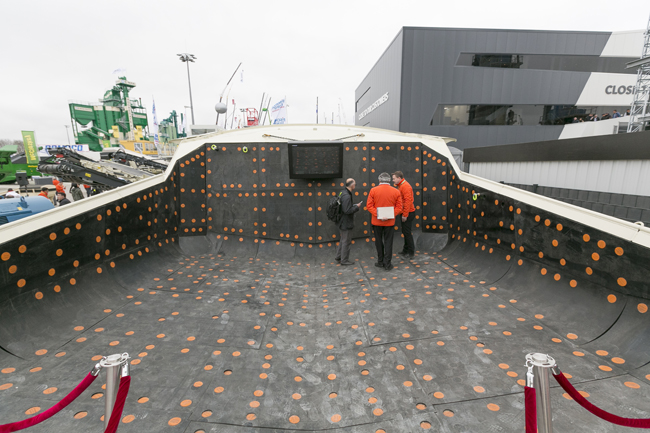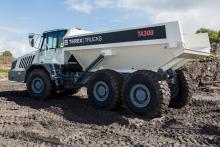
The recent bauma 2019 exhibition in Munich, Germany, saw many new hauling stars get their worldwide unveiling. Guy Woodford reports
The new
Lars Skoog, vice president, Mining Wear Lining & Screening, Metso, said: “Hauling is one of the most cost-intensive components of a typical mining or quarrying operation. In addition to fuel and labour, there’s plenty of maintenance involved too. To ensure cost efficiency, a haul truck should carry as much payload as possible on every round. At Metso, we set out to tackle this challenge and designed a truck body that requires minimal maintenance while maximising payload. The result is a lower operating cost per hauled tonne.”
The
Metso has been supplying its tried-and-tested rubber lining for haul trucks for several decades with eye-catching results, both in reducing the need for maintenance and improving the working environment for truck drivers. The proven benefits include, says Metso, up to six times more wear life compared to traditional steel lining, half the noise, and 97% less vibration. The new Metso Truck Body innovation is said to take this concept to another level by combining the wear protection and working environment benefits of rubber with the payload-maximising abilities of a lightweight body.
“Many mines or quarries prefer lightweight truck bodies because they enable the carrying of more payload. However, the problem with these traditional lightweight bodies is their lack of durability - they often need to be replaced in every one or two years, or repaired, which gets expensive,” Skoog explains.
“The Metso Truck Body provides an unprecedented solution that is both light and durable. The rubber lining and high structural strength steel frame have been engineered in a seamless process, utilising the best qualities of both materials,” he continues.
A typical Metso Truck Body is said to weigh 20-30% less than a traditional steel-lined truck body. Depending on the application, this translates into a payload increase of several tonnes.
The Metso Truck Body is available globally for all major off-highway truck models used in mining and quarrying. Several lining options ensure application-specific fit, even in operations that struggle with problems such as carry-back.
Terex Trucks launched its updated TA300 articulated hauler at bauma 2019. The TA300 benefits from the new EP320 transmission, which comes with two additional forward gears – eight in total – as well as four reverse gears. This helps to ensure smoother gear shifting and thereby superior operator comfort.
In addition to this, the TA300 now delivers a claimed 5% improvement in fuel efficiency, as well as enhanced performance, productivity and operator comfort. It also now comes with long-life transmission fluid, which has helped to increase the length of time between oil maintenance intervals from 1,000 to 4,000 hours.
The hauler’s maximum speed has also increased to 55km/h, up from 50km/h.
“The TA300 is one of our staple products, hence why we worked long and hard to make it even better for our customers,” said Terex Trucks MD Paul Douglas. “The upgraded TA300 was rigorously tested for nearly two years internally and by operators on real job sites, working in a variety of conditions.”
The new Map feature on Volvo’s updated Haul Assist application now allows operators to monitor the hauler traffic around a quarry or mine site and proactively adjust their driving according to traffic conditions, especially around load and dump zones.
Operated via Volvo Co-Pilot — the award-winning in-cab interface with a 25.5cm-high-resolution touch screen — Haul Assist’s Map functionality allows operators to not only identify their position but also the position of other haulers fitted with the technology. This knowledge comes into its own on sites with restricted visibility, allowing operators to see where the other haulers are, a feature that should reduce potentially dangerous situations. In all circumstances, being able to monitor traffic flow helps operators anticipate the optimum arrival time at load or dump areas and avoid congestion and waiting times … the best way to improve overall site efficiency.
The application works by using the hauler’s in-built GPS function for positioning purposes and combines it with a digital connection via Volvo Co-Pilot to communicate with other machines. The system can also record how fast the hauler is travelling and emit an alert to remind operators to maintain a safe working speed.
The Map function can plot out haul roads and preferred routes to help operators navigate their way around the site. It can highlight when the hauler is approaching a pre-defined section of narrow or single lane road, and even visualise meeting/passing areas. The map can also highlight any reference points or notable areas of the site.
Load and dump zones can not only be visualised on the map, but can also trigger certain sub-functions, such as activating on-board weighing information. On-board weighing helps to optimise the haul cycle by ensuring every hauler journey moves the correct payload. The highly accurate system eliminates under-loading for good productivity and over-loading that increases machine wear and fuel consumption.










